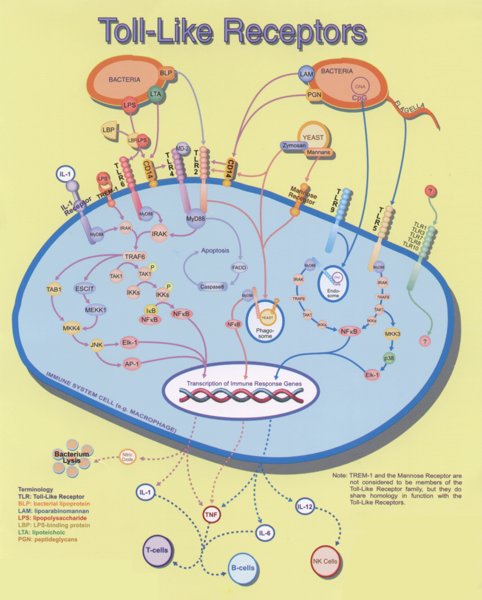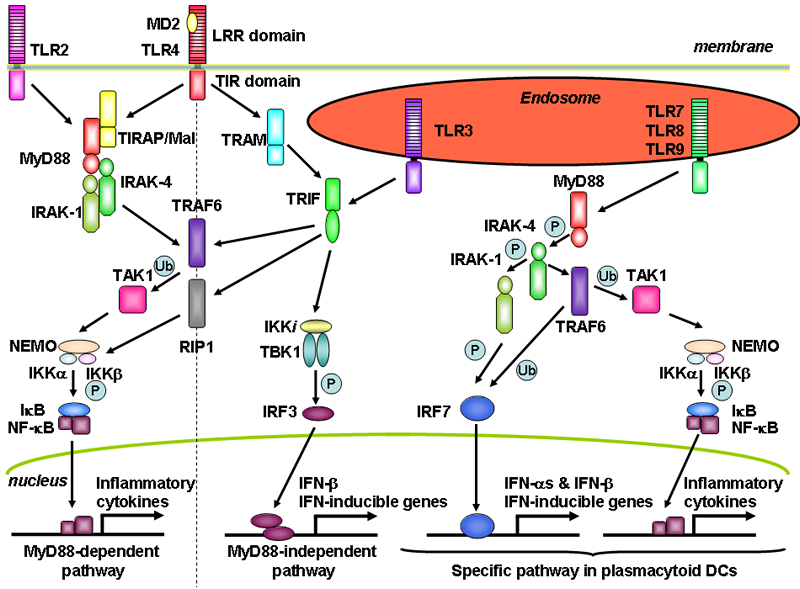Backround and Signalling Pathway
From 2006.igem.org
| Line 29: | Line 29: | ||
After binding of bacterial constituents to TLR, its intracellular TIR-domain interacts with either MyD88 (MyD88 dependent way) or TRIF (MyD88 independent way), two signaling molecules in the cytoplasm that transmit signal to other components of the cascade, as shown on picture below. TLR4 can induce response through both ways, TLR5 only through MyD88 depended. | After binding of bacterial constituents to TLR, its intracellular TIR-domain interacts with either MyD88 (MyD88 dependent way) or TRIF (MyD88 independent way), two signaling molecules in the cytoplasm that transmit signal to other components of the cascade, as shown on picture below. TLR4 can induce response through both ways, TLR5 only through MyD88 depended. | ||
| - | [[Image:Scheme1.jpg|center|260 px]] | + | [[Image:Scheme1.jpg|thumb|center|260 px]] |
'''''MyD88 dependent pathway''''' | '''''MyD88 dependent pathway''''' | ||
| Line 45: | Line 45: | ||
-popravi grške črke | -popravi grške črke | ||
-zgornji odstavek gre v rubriko home | -zgornji odstavek gre v rubriko home | ||
| + | označi za vsako sliko, kaj pomeni in od kod je | ||
<hr> | <hr> | ||
Revision as of 10:27, 20 October 2006

| Backround and Signalling Pathway | Proposal & Approach | Anticipated Results & Significance | Troubleshooting, References & Sponsors | Team members |
|---|
Although in the past years all participating iGEM teams focused on bacteria and yeasts, we decided to modify signalling pathways in higher eukaryotes, t.i. in human cells. This is far more complicated system to understand but we feel that the recently accumulated knowledge enables rational planning of cells with novel properties.
Background
When bacteria invade the human body, it has to respond quickly by activation of the innate branch of the immune system, which recognizes the broad spectrum of molecules, specifical for pathogenic microorganisms. Cells which represent the first line of defence are macrophages and the way they act is rather complicated. On the surface of these cells (actually inserted into cell membrane) are several types of receptor molecules, commonly abbreviated as TLR (toll-like receptors). These can specifically bind various components of bacteria (e.g. lipopolysaccharides which are part of <teing added constantly. This kind of cell signalling is the basis of our efficient innate immune response (i.e. the fast-acting, not mediated by antibodies) against microbes. In some instances, however, extensive signalling mediated by TLR is not beneficial. Under some not yet fully understood circumstances, bacteria can trigger this same signalling pathway just that it results in excessive inflammatory response. As result, sepsis occurs, which can lead to severe organ failure and in about 20% cases cosequences are fatal. Response to bacterial stimulus is a double-edged sword - too strong response may lead to sepsis, while the too weak response does not contain the bacterial infection, therefor both extremes have to be in the balance.
Signalling pathway of bacterial recognition of the human innate immune system
Toll like receptors (TLRs) are key regulators of innate immunity, sensing and responding to invading microorganisms. So far we know eleven different receptors that recognize specific molecular patterns that are present in microbial components, e.g. lipopeptides, double and single stranded RNA of viruses, CpG containing DNA, glycolipids, and variety of others. We have focused on TLR4 and TLR5 that respond to presence of LPS and flagellin respectively, so both sense the presence of bacteria.
After binding of bacterial constituents to TLR, its intracellular TIR-domain interacts with either MyD88 (MyD88 dependent way) or TRIF (MyD88 independent way), two signaling molecules in the cytoplasm that transmit signal to other components of the cascade, as shown on picture below. TLR4 can induce response through both ways, TLR5 only through MyD88 depended.
MyD88 dependent pathway
When receptors sense the presence of microbial components, stimulation of TLRs occurs and triggers the association of MyD88 (myeloid differentiation primary-response protein 88), which in turn recruits IRAK4, thereby allowing association with IRAK1. IRAK4 phosphorylates IRAK1 and with phosphorylated IRAK1, TRAF6 (tumour-necrosis-factor receptor- associated factor 6) associates. The complex of phosphorylated IRAK1 and TRAF6 dissociats from the receptor and form a complex with TAK1, TAB1 and TAB2, which induces the phosphorylation of TAB2 and TAK1. This leads to the ubiquitylation of TRAF6, which induces the activation of TAK1. TAK1 phosphorylates IKK complex (inhibitor of nuclear factor-?B (I?B)-kinase complex), which consists of IKK-?, IKK-ß and IKK-?. The IKK complex then phosphorylates I?B, which leads to its ubiquitylation and subsequent degradation. This allows NF-?B to translocate to the nucleus and to induce the expression of its target genes, such as cytokines and chemokines. Inflammatory cytokines, chemokines and interferons attract cells of immune system (lymphocytes, macrophages) to infected area. This seems to be beneficial to organism, but it can also lead to severe inflammation and sepsis. Some receptors mediate response through MyD88-independent pathway. A number of genes known to be interferon(IFN)-inducible genes was identified.
komentarji: -Jelka mi pošlje enostavnejšo sliko za na začetek -Home tudi na začetku -popravi grške črke -zgornji odstavek gre v rubriko home označi za vsako sliko, kaj pomeni in od kod je

